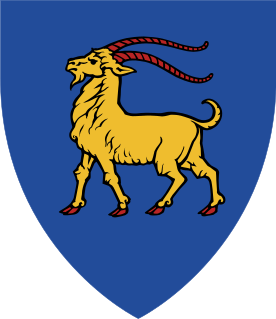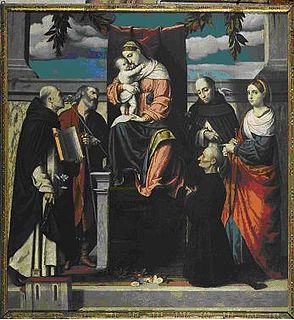
Giorgio Ventura (also Zorzi Ventura) was an Italian mannerist painter of the Venetian school, active mainly in Venice, Istria and Dalmatia at the turn of the 16th and 17th centuries. [1]

Giorgio Ventura (also Zorzi Ventura) was an Italian mannerist painter of the Venetian school, active mainly in Venice, Istria and Dalmatia at the turn of the 16th and 17th centuries. [1]

At present, almost nothing is known about his life, except what written from the cartouche of one of his most famous paintings, a Madonna and Child with Saints Sebastian and Roch, held in the parish church of Izola in which he wrote Zorzi Ventura Zaratino in Capodistria Pingieva 1603.
Born probably in Zadar, Dalmatia in an unknown year, most likely the second half of the 16th century, he left only one painting in Dalmatia: the Virgin with Six Saints, in the small church of the Franciscans on the island of St. Paul, near Zadar.
Traditionally it is believed that his activities in Venice and Istria began in 1598 when he signed and dated an Ultima Cena now kept in the parish church of Fažana. In 1607 he signed his latest Istrian work: the Concert of St. Cecilia in the church of St. Cecilia of Vabriga (close to Poreč). Ventura is no longer mentioned thereafter.
He knew and studied Vittore Carpaccio and Girolamo Santacroce. The architecture and background of the paintings of Izola and Villa Decani suggest the knowledge of other painters of the Venetian tradition.
In addition to the already mentioned painting, the following are attributed to Giorgio Ventura:

Istria, formerly Histria (Latin), Ίστρια, is the largest peninsula within the Adriatic Sea. The peninsula is located at the head of the Adriatic between the Gulf of Trieste and the Kvarner Gulf. It is shared by three countries: Croatia, Slovenia, and Italy. Croatia encapsulates most of the Istrian peninsula with its Istria County.

Zadar is the oldest continuously inhabited Croatian city. It is situated on the Adriatic Sea, at the northwestern part of Ravni Kotari region. Zadar serves as the seat of Zadar County and of the wider northern Dalmatian region. The city proper covers 25 km2 (9.7 sq mi) with a population of 75,082 in 2011, making it the second-largest city of the region of Dalmatia and the fifth-largest city in the country.

Carlo Saraceni was an Italian early-Baroque painter, whose reputation as a "first-class painter of the second rank" was improved with the publication of a modern monograph in 1968.

Carlo Crivelli was an Italian Renaissance painter of conservative Late Gothic decorative sensibility, who spent his early years in the Veneto, where he absorbed influences from the Vivarini, Squarcione and Mantegna. He left the Veneto by 1458 and spent most of the remainder of his career in the March of Ancona, where he developed a distinctive personal style that contrasts with that of his Venetian contemporary Giovanni Bellini.

Giorgio da Sebenico was a Venetian sculptor and architect from Dalmatia, who worked mainly in Sebenico, and in the city of Ancona, then a maritime republic.

Federico Bencovich was a prominent late Baroque painter from Dalmatia working in Italy. He is best known as Federico Bencovich or Federigo or Federighetto or Dalmatino. In modern Croatia he is known as Federiko Benković.

Dalmatian Italians are the historical Italian national minority living in the region of Dalmatia, now part of Croatia and Montenegro. Since the middle of the 19th century, the community, counting according to some sources nearly 20% of all Dalmatian population in 1840, suffered from a constant trend of decreasing presence and now numbers only around 1,000–4,000 people. Throughout history, though small in numbers in the last two centuries, it exerted a vast and significant influence on the region.

Ottavio Amigoni was an Italian painter of the Baroque period, active in Brescia. He was trained by Antonio Gandini. Among his masterpieces is a large fresco about the life of Sant'Alberto in the Carmelite church of Brescia, painted with Gandino's son, Bernardino.
Matteo Ponzone was an Italian painter of the Baroque period, active between 1630 and 1700 mainly in Venice. He was a pupil of Santo Peranda. Several of his works are in the churches and public buildings of Venice, particularly in San Giorgio Maggiore, and in the church of the "Padri Croceferi".

The Basilica of San Domenico, also known as Basilica Cateriniana, is a basilica church in Siena, Tuscany, Italy, one of the most important in the city.

The Diet of Dalmatia was the regional assembly of the Kingdom of Dalmatia within the Austro-Hungarian Empire. It was founded in Zadar in 1861 and last convened in 1912, before being formally dissolved in 1918, with the demise of the Empire.

Francesco Bonsignori, also known as Francesco Monsignori, was an Italian painter and draughtsman, characterized by his excellence in religious subjects, portraits, architectural perspective and animals. He was born in Verona and died in Caldiero, a city near Verona. Bonsignori's style in early period was under the influence of his teacher Liberale da Verona. After becoming the portraitist and court artist to the Gonzaga family of Mantua in 1487, his style was influenced by Andrea Mantegna, who also worked for Francesco Gonzaga from the 1480s. They collaborated to execute several religious paintings, mainly with the theme of Madonna and Child. The attribution of theportrait of a Venetian Senator was debatable until the last century because of the similarity in techniques used by Bonsignori and his teacher Mantegna. During the phase of his career in Mantua, there is an undocumented period between 1495 and July 1506 with no official record regarding his activities by the court of Mantua. Bonsignori's late style was decisively influenced by Lorenzo Costa in terms of form and color. He produced his last monumental altarpiece the Adoration of the Blessed Osanna Andreasi in 1519 shortly before his death.

The Stato da Màr or Domini da Mar was the name given to the Republic of Venice's maritime and overseas possessions from around 1000 to 1797, including at various times parts of what are now Istria, Dalmatia, Montenegro, Albania, Greece and notably the Ionian Islands, Peloponnese, Crete, Cyclades, Euboea, as well as Cyprus.

Istrian Italians are an ethnic group from the Adriatic region of Istria in modern northwestern Croatia and southwestern Slovenia. Istrian Italians descend from the original Latinized population of Roman Histria, from the Venetian-speaking settlers who settled in the region during the time of the Republic of Venice, and from the local South Slavic people who culturally assimilated.

Pier Alessandro Paravia was a Italian writer, scholar, philanthropist and professor of Italian eloquence at the University of Turin.

Venetian Dalmatia refers to parts of Dalmatia under the rule of the Republic of Venice, mainly from the 16th to the 18th centuries. The first possessions were acquired around 1000, having taken the coastal parts of the Kingdom of Croatia, but Venetian Dalmatia was fully consolidated from 1420 and lasted until 1797 when the republic disappeared with Napoleon's conquests.

Madonna and Child with Saint George is an oil on panel painting by Correggio dating to around 1530 and now in the Gemäldegalerie in Dresden.

The Orzinuovi Altarpiece or Enthroned Madonna and Child with Saints Dominic, Joseph, Vincent Ferrer, Lucy and a Commissioner is a 1525–1530 oil on canvas painting by Moretto da Brescia on the wall of the chancel of the church of San Domenico in Orzinuovi.

Andrea Carrera or Carreca was an Italian Baroque painter mainly active in Sicily. He was born in Trapani and died in Palermo.
This is an alphabetical index of people, places, things, and concepts related to or originating from the Republic of Venice. Feel free to add more, and create missing pages.
Questo pittore quasi dimenticato, di nome Giorgio Ventura è stato riabilitato negli ultimi anni nonostante gli accenti provincializzanti e ritardatari delle sue tele per la sua personale tipologìa, per le sue qualità coloristiche riscoperte dopo i ...
![]() Media related to Giorgio Ventura at Wikimedia Commons
Media related to Giorgio Ventura at Wikimedia Commons